The “Bad Rabbit Attack” pop-up alerts are misleading advertising that created in order to trick you into calling a fake Windows Support Service. If you keep receiving the Bad Rabbit Attack misleading ads, when you surf the Internet with the Mozilla Firefox, Internet Explorer, Google Chrome and Edge, then it could mean ‘ad-supported’ software (also known as adware) was installed on your system. Once started, it may generate a huge count of pop-up ads or modify the web browser’s settings to show ads on all web-pages that you are opening in the web browser, even on those sites where before you did not see any advertisements. We recommend you to clean you computer from ad-supported software and thereby get rid of “Bad Rabbit Attack” popup ads. You need to follow the instructions below sooner. It’ll get rid of all annoying pop-up ads and protect your system from more malicious apps and trojans.
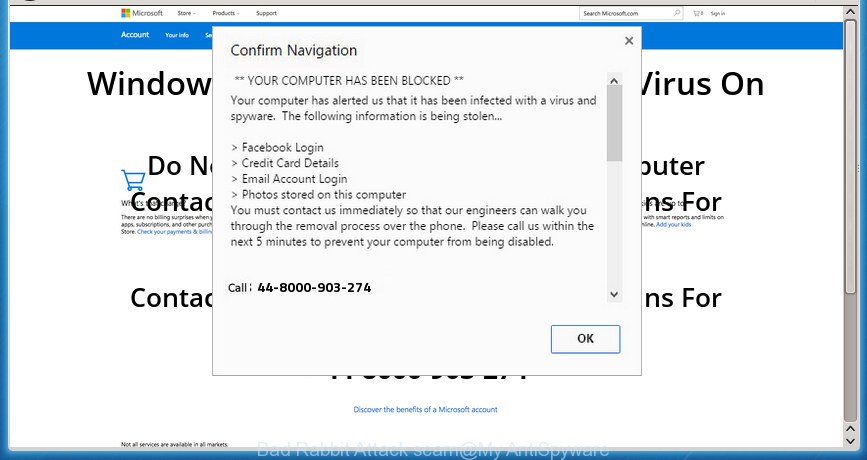
The “Bad Rabbit Attack” pop-up alerts are misleading advertising like shown above
The adware responsible for redirecting your web-browser to “Bad Rabbit Attack” web page, is the part of the software that is used as an online promotional utility. It is developed with the sole purpose to open dozens of pop ups, and thus to promote the goods and services in an open browser window. Moreover, the adware can substitute the legitimate advertising links on misleading or even banners that can offer to visit harmful pages. The reason is simple, many advertisers agree on any ways to attract users to their sites, so the authors of adware, often forcing users to click on an advertising link. For each click on a link, the developers of the adware receive income.
The malicious software from the adware family that modifies the settings of internet browsers usually infects only the Google Chrome, Microsoft Edge, Microsoft Internet Explorer and Firefox. However, possible situations, when any other web browsers will be hijacked too. The adware may change the Target property of a internet browser’s shortcut, so every time you open the browser, instead of your homepage, you will see the annoying “Bad Rabbit Attack” site.
The tutorial below explaining steps to remove “Bad Rabbit Attack” advertisements problem. Feel free to use it for removal of the ‘ad supported’ software that may attack Google Chrome, Microsoft Edge, Mozilla Firefox and Internet Explorer and other popular browsers. The steps will help you get rid of ad-supported software and thereby clean your browser from all intrusive ads.
Remove “Bad Rabbit Attack” pop-up scam
In the steps below we will have a look at the adware and how to delete “Bad Rabbit Attack” from Chrome, Microsoft Internet Explorer, Edge and Firefox web browsers for MS Windows OS, natively or by using a few free removal utilities. Some of the steps will require you to restart your personal computer or exit this web site. So, read this guidance carefully, then bookmark or print it for later reference.
To remove “Bad Rabbit Attack”, follow the steps below:
- How to remove “Bad Rabbit Attack” popup ads without any software
- Remove potentially unwanted software using Microsoft Windows Control Panel
- Remove “Bad Rabbit Attack” ads from Microsoft Internet Explorer
- Remove “Bad Rabbit Attack” from Mozilla Firefox by resetting internet browser settings
- Remove “Bad Rabbit Attack” pop up ads from Chrome
- Get rid of unwanted Scheduled Tasks
- Clean up the web-browsers shortcuts that have been affected by adware
- How to get rid of “Bad Rabbit Attack” pop-up ads with free software
- Run AdBlocker to stop “Bad Rabbit Attack” and stay safe online
- How did “Bad Rabbit Attack” ads get on your PC
- Finish words
How to remove “Bad Rabbit Attack” popup ads without any software
The step by step guide will help you delete “Bad Rabbit Attack” pop-up advertisements. These “Bad Rabbit Attack” removal steps work for the Edge, Mozilla Firefox, IE and Google Chrome, as well as every version of MS Windows operating system.
Remove potentially unwanted software using Microsoft Windows Control Panel
First of all, check the list of installed software on your computer and remove all unknown and recently installed apps. If you see an unknown program with incorrect spelling or varying capital letters, it have most likely been installed by malicious software and you should clean it off first with malicious software removal tool such as Zemana Anti-malware.
Windows 10, 8.1, 8
Click the Microsoft Windows logo, and then click Search ![]() . Type ‘Control panel’and press Enter as displayed below.
. Type ‘Control panel’and press Enter as displayed below.

After the ‘Control Panel’ opens, click the ‘Uninstall a program’ link under Programs category as displayed below.

Windows 7, Vista, XP
Open Start menu and select the ‘Control Panel’ at right as on the image below.

Then go to ‘Add/Remove Programs’ or ‘Uninstall a program’ (Microsoft Windows 7 or Vista) as displayed on the screen below.

Carefully browse through the list of installed applications and remove all questionable and unknown programs. We advise to press ‘Installed programs’ and even sorts all installed software by date. After you’ve found anything questionable that may be the adware that cause intrusive “Bad Rabbit Attack” pop-up ads to appear or other PUP (potentially unwanted program), then choose this program and click ‘Uninstall’ in the upper part of the window. If the suspicious application blocked from removal, then use Revo Uninstaller Freeware to fully get rid of it from your PC system.
Remove “Bad Rabbit Attack” ads from Microsoft Internet Explorer
In order to restore all internet browser search engine by default, newtab page and home page you need to reset the IE to the state, which was when the Microsoft Windows was installed on your computer.
First, launch the IE, click ![]() ) button. Next, press “Internet Options” as shown on the image below.
) button. Next, press “Internet Options” as shown on the image below.

In the “Internet Options” screen select the Advanced tab. Next, press Reset button. The Internet Explorer will display the Reset Internet Explorer settings prompt. Select the “Delete personal settings” check box and click Reset button.

You will now need to reboot your PC for the changes to take effect. It will get rid of ad supported software that causes browsers to display unwanted “Bad Rabbit Attack” popup advertisements, disable malicious and ad-supported web-browser’s extensions and restore the IE’s settings such as default search engine, homepage and new tab to default state.
Remove “Bad Rabbit Attack” from Mozilla Firefox by resetting internet browser settings
If the FF settings such as start page, newtab page and search provider have been replaced by the adware, then resetting it to the default state can help.
Run the Firefox and click the menu button (it looks like three stacked lines) at the top right of the web browser screen. Next, click the question-mark icon at the bottom of the drop-down menu. It will open the slide-out menu.
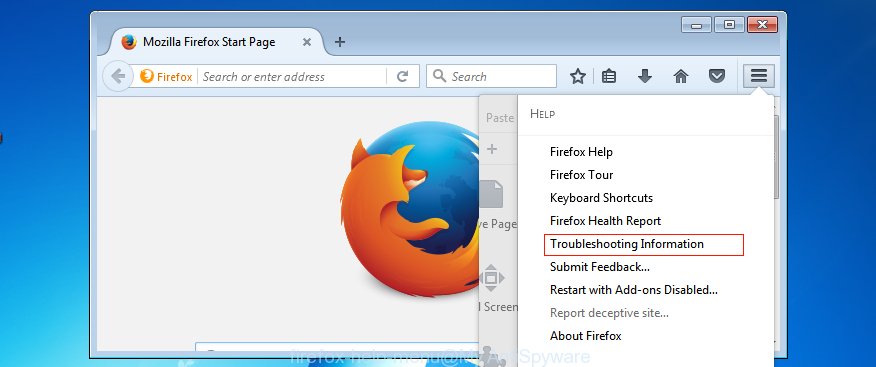
Select the “Troubleshooting information”. If you’re unable to access the Help menu, then type “about:support” in your address bar and press Enter. It bring up the “Troubleshooting Information” page like below.
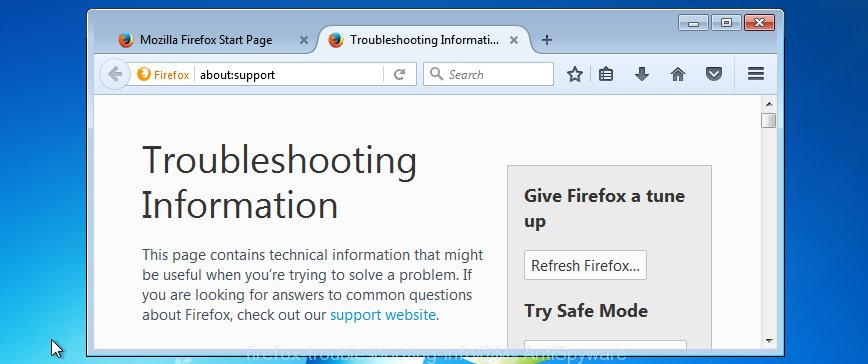
Click the “Refresh Firefox” button at the top right of the Troubleshooting Information page. Select “Refresh Firefox” in the confirmation prompt. The Firefox will begin a task to fix your problems that caused by the adware which cause unwanted “Bad Rabbit Attack” ads to appear. When, it’s done, click the “Finish” button.
Remove “Bad Rabbit Attack” pop up ads from Chrome
Reset Google Chrome settings is a easy way to get rid of the hijackers, harmful and ‘ad-supported’ extensions, as well as to restore the web-browser’s default search provider, startpage and new tab that have been replaced by ad supported software that responsible for the appearance of “Bad Rabbit Attack” pop up advertisements.
Open the Google Chrome menu by clicking on the button in the form of three horizontal dotes (![]() ). It will show the drop-down menu. Choose More Tools, then click Extensions.
). It will show the drop-down menu. Choose More Tools, then click Extensions.
Carefully browse through the list of installed addons. If the list has the extension labeled with “Installed by enterprise policy” or “Installed by your administrator”, then complete the following tutorial: Remove Google Chrome extensions installed by enterprise policy otherwise, just go to the step below.
Open the Chrome main menu again, click to “Settings” option.

Scroll down to the bottom of the page and click on the “Advanced” link. Now scroll down until the Reset settings section is visible, as displayed in the figure below and press the “Reset settings to their original defaults” button.

Confirm your action, click the “Reset” button.
Get rid of unwanted Scheduled Tasks
If the intrusive “Bad Rabbit Attack” page opens automatically on Windows startup or at equal time intervals, then you need to check the Task Scheduler Library and delete all the tasks that have been created by malicious software.
Press Windows and R keys on the keyboard simultaneously. This displays a prompt that called Run. In the text field, type “taskschd.msc” (without the quotes) and press OK. Task Scheduler window opens. In the left-hand side, press “Task Scheduler Library”, as displayed on the image below.
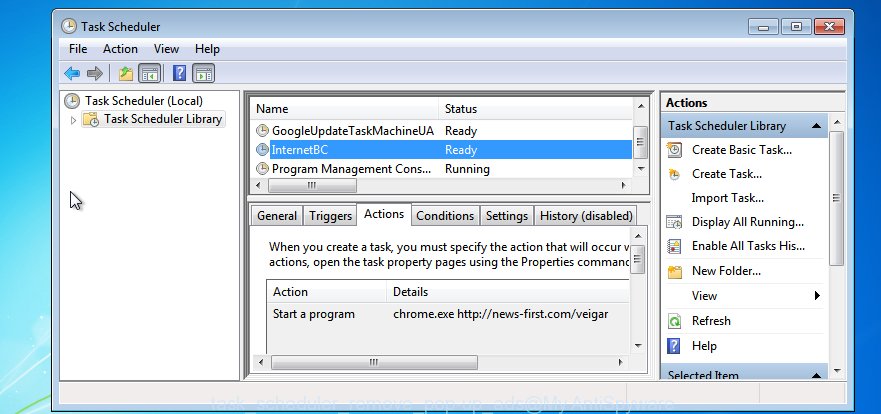
Task scheduler
In the middle part you will see a list of installed tasks. Please choose the first task, its properties will be open just below automatically. Next, press the Actions tab. Pay attention to that it launches on your PC. Found something like “explorer.exe http://site.address” or “chrome.exe http://site.address”, then remove this malicious task. If you are not sure that executes the task, check it through a search engine. If it’s a component of the adware, then this task also should be removed.
Having defined the task that you want to remove, then click on it with the right mouse button and select Delete as shown below.

Delete a task
Repeat this step, if you have found a few tasks that have been created by adware. Once is finished, close the Task Scheduler window.
Clean up the web-browsers shortcuts that have been affected by adware
When the adware is started, it can also modify the internet browser’s shortcuts, adding an argument similar to “http://site.address” into the Target field. Due to this, every time you open the web browser, it will show an annoying page.
Open the properties of the web-browser shortcut file. Right click on the shortcut file of infected internet browser and choose the “Properties” option and it will display the properties of the shortcut file. Next, select the “Shortcut” tab and have a look at the Target field like below.
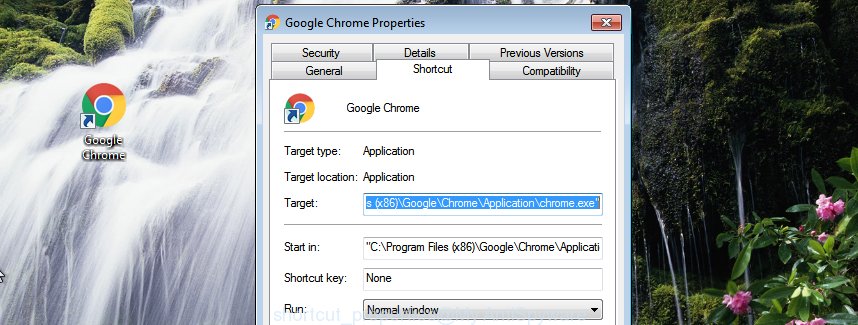
Normally, if the last word in the Target field is chrome.exe, iexplore.exe, firefox.exe. Be sure to pay attention to the extension, should be “exe”! All shortcuts that have been altered by adware responsible for “Bad Rabbit Attack” popups, usually point to .bat, .cmd or .url files instead of .exe as displayed below

Another variant, an address has been added at the end of the line. In this case the Target field looks such as …Application\chrome.exe” http://site.address as shown on the screen below.

In order to fix the infected shortcut file, you need to insert right path to the Target field or remove an address (if it has been added at the end). You can use the following information to fix your shortcuts that have been changed by adware which created to redirect your web-browser to various ad pages like “Bad Rabbit Attack”.
| Chrome | C:\Program Files (x86)\Google\Chrome\Application\chrome.exe |
| C:\Program Files\Google\Chrome\Application\chrome.exe | |
| Firefox | C:\Program Files\Mozilla Firefox\firefox.exe |
| Internet Explorer | C:\Program Files (x86)\Internet Explorer\iexplore.exe |
| C:\Program Files\Internet Explorer\iexplore.exe | |
| Opera | C:\Program Files (x86)\Opera\launcher.exe |
| C:\Program Files\Opera\launcher.exe |
Once is finished, click OK to save changes. Repeat the step for all web browsers that are re-directed to the “Bad Rabbit Attack” unwanted web page.
How to get rid of “Bad Rabbit Attack” pop-up ads with free software
Manual removal is not always as effective as you might think. Often, even the most experienced users can not completely remove adware that responsible for web browser redirect to the intrusive “Bad Rabbit Attack” site. So, we recommend to scan your computer for any remaining harmful components with free adware removal programs below.
Get rid of “Bad Rabbit Attack” pop ups with Zemana Anti-malware
We suggest you to use the Zemana Anti-malware that are completely clean your computer of ‘ad supported’ software responsible for redirecting your internet browser to “Bad Rabbit Attack” page. Moreover, the tool will help you to delete PUPs, malware, toolbars and browser hijackers that your PC system can be infected too.
Download Zemana Free on your computer from the link below.
164806 downloads
Author: Zemana Ltd
Category: Security tools
Update: July 16, 2019
After downloading is finished, close all software and windows on your PC system. Double-click the install file called Zemana.AntiMalware.Setup. If the “User Account Control” dialog box pops up as displayed on the image below, click the “Yes” button.

It will open the “Setup wizard” that will help you set up Zemana Free on your system. Follow the prompts and do not make any changes to default settings.

Once installation is complete successfully, Zemana Anti Malware (ZAM) will automatically start and you can see its main screen as on the image below.

Now press the “Scan” button for scanning your personal computer for the ad-supported software which created to redirect your web browser to various ad web-pages such as “Bad Rabbit Attack”. Depending on your PC, the scan can take anywhere from a few minutes to close to an hour.

As the scanning ends, you may check all threats detected on your machine. All found items will be marked. You can remove them all by simply press “Next” button. The Zemana will remove adware which cause unwanted “Bad Rabbit Attack” ads to appear and add threats to the Quarantine. When disinfection is complete, you may be prompted to reboot the system.
Delete “Bad Rabbit Attack” pop ups from web browsers with HitmanPro
Hitman Pro is a portable program which requires no hard install to search for and remove adware that causes unwanted “Bad Rabbit Attack” pop up advertisements. The program itself is small in size (only a few Mb). HitmanPro does not need any drivers and special dlls. It’s probably easier to use than any alternative malicious software removal tools you have ever tried. Hitman Pro works on 64 and 32-bit versions of Windows 10, 8, 7 and XP. It proves that removal tool can be just as useful as the widely known antivirus programs.
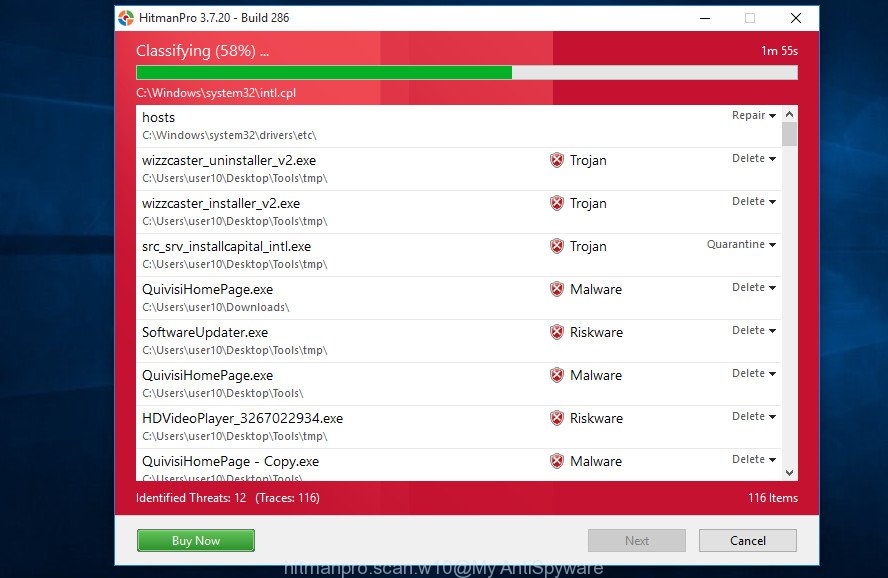
- Please go to the link below to download HitmanPro. Save it to your Desktop.
- Once downloading is done, start the Hitman Pro, double-click the HitmanPro.exe file.
- If the “User Account Control” prompts, press Yes to continue.
- In the HitmanPro window, press the “Next” to scan for ad-supported software that responsible for the appearance of “Bad Rabbit Attack” pop up advertisements. A system scan may take anywhere from 5 to 30 minutes, depending on your PC. While the utility is checking, you can see how many objects and files has already scanned.
- After that process is finished, HitmanPro will show a list of detected threats. You may remove items (move to Quarantine) by simply click “Next”. Now, press the “Activate free license” button to begin the free 30 days trial to delete all malicious software found.
How to remove “Bad Rabbit Attack” with Malwarebytes
Manual “Bad Rabbit Attack” popups removal requires some computer skills. Some files and registry entries that created by the adware can be not completely removed. We advise that use the Malwarebytes Free that are completely free your computer of adware. Moreover, the free program will help you to delete malicious software, PUPs, browser hijacker infections and toolbars that your PC can be infected too.
Download MalwareBytes Anti-Malware from the link below. Save it on your Microsoft Windows desktop or in any other place.
327059 downloads
Author: Malwarebytes
Category: Security tools
Update: April 15, 2020
Once the download is done, close all windows on your PC. Further, run the file named mb3-setup. If the “User Account Control” prompt pops up as shown below, press the “Yes” button.
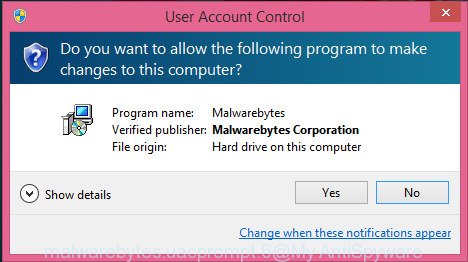
It will show the “Setup wizard” which will assist you install MalwareBytes on the system. Follow the prompts and don’t make any changes to default settings.
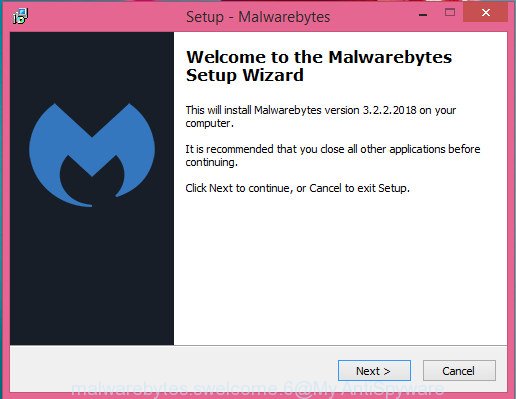
Once setup is finished successfully, click Finish button. Then MalwareBytes Free will automatically start and you can see its main window like below.
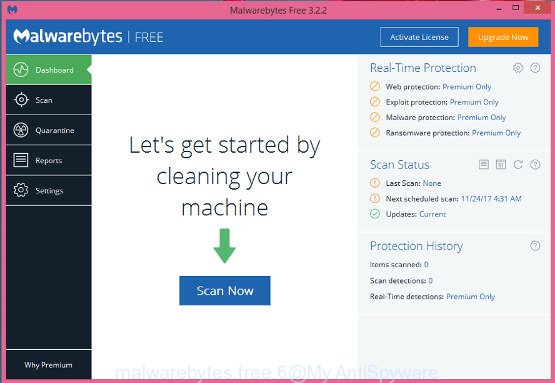
Next, click the “Scan Now” button . MalwareBytes Free program will scan through the whole PC for the adware responsible for “Bad Rabbit Attack” redirect. A system scan can take anywhere from 5 to 30 minutes, depending on your computer. During the scan MalwareBytes Free will detect threats present on your system.
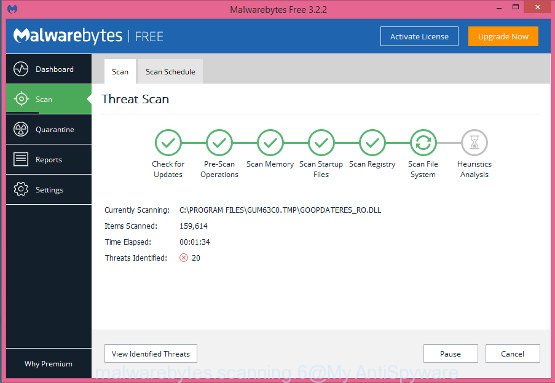
When finished, MalwareBytes will create a list of undesired and adware. Make sure all threats have ‘checkmark’ and press “Quarantine Selected” button.
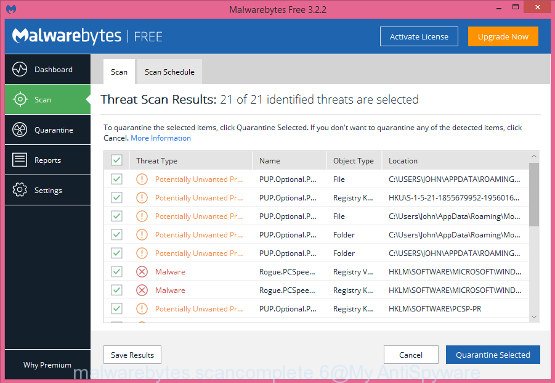
The MalwareBytes AntiMalware (MBAM) will get rid of adware that causes web-browsers to show annoying “Bad Rabbit Attack” ads. After finished, you can be prompted to restart your PC. We recommend you look at the following video, which completely explains the process of using the MalwareBytes Free to delete browser hijackers, ad supported software and other malware.
Run AdBlocker to stop “Bad Rabbit Attack” and stay safe online
It is also critical to protect your internet browsers from malicious web-sites and advertisements by using an ad blocker program such as AdGuard. Security experts says that it will greatly reduce the risk of malicious software, and potentially save lots of money. Additionally, the AdGuard may also protect your privacy by blocking almost all trackers.
Installing the AdGuard is simple. First you’ll need to download AdGuard by clicking on the following link.
26841 downloads
Version: 6.4
Author: © Adguard
Category: Security tools
Update: November 15, 2018
After the downloading process is done, run the downloaded file. You will see the “Setup Wizard” screen like below.

Follow the prompts. When the install is complete, you will see a window as shown on the screen below.

You can click “Skip” to close the setup application and use the default settings, or click “Get Started” button to see an quick tutorial that will assist you get to know AdGuard better.
In most cases, the default settings are enough and you don’t need to change anything. Each time, when you start your system, AdGuard will run automatically and block pop-up ads, “Bad Rabbit Attack” redirect, as well as other malicious or misleading sites. For an overview of all the features of the program, or to change its settings you can simply double-click on the AdGuard icon, that can be found on your desktop.
How did “Bad Rabbit Attack” ads get on your PC
The adware may be spread with the help of trojan horses and other forms of malicious software, but in many cases, the adware gets onto PC by being attached to certain freeware. Many creators of free software include third-party apps in their setup file. Sometimes it’s possible to avoid the installation of any ‘ad supported’ software: carefully read the Terms of Use and the Software license, choose only Manual, Custom or Advanced install mode, uncheck all checkboxes before clicking Install or Next button while installing new freeware.
Finish words
Now your computer should be free of the ad-supported software related to “Bad Rabbit Attack” pop-up ads. We suggest that you keep AdGuard (to help you block unwanted pop-ups and undesired malicious sites) and Zemana Anti Malware (ZAM) (to periodically scan your personal computer for new malware, hijackers and ad-supported software). Make sure that you have all the Critical Updates recommended for Microsoft Windows OS. Without regular updates you WILL NOT be protected when new hijackers, malicious software and ‘ad supported’ software are released.
If you are still having problems while trying to remove “Bad Rabbit Attack” redirect from your browser, then ask for help in our Spyware/Malware removal forum.




















